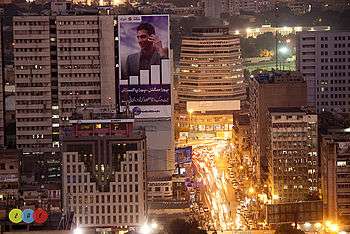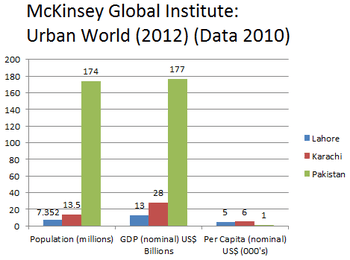Economy of Karachi

Karachi is referred as the financial capital of Pakistan; it accounts for most of Pakistan's revenue generation. It generates about half of the total collections of the Federal Board of Revenue, out of which, approximately half are customs duty and sales tax on imports.[1] Karachi produces about 30 percent of value added in large scale manufacturing[2] and 20%[3][4] of the GDP of Pakistan. In February 2007, the World Bank identified Karachi as the most business-friendly city in Pakistan.[5] In 2010, research by the global human resources company Mercer found Karachi to be the most inexpensive city in the world.[6]
GDP


A substantial chunk of Sindh’s GDP is attributed to Karachi[8][9] (the GDP of Sindh as a percentage of Pakistan’s total GDP has traditionally hovered around 29%/30%).[8][9][10][11] Karachi’s GDP is around 20% of the total GDP of Pakistan.[3][4] A PricewaterhouseCoopers study released in 2009, which surveyed the 2008 GDP of the top cities in the world, calculated Karachi’s GDP (PPP) to be $78 billion[12] (projected to be $193 billion in 2025 at a growth rate of 5.5%).[12] It confirmed Karachi’s status as Pakistan’s largest economy, well ahead of the next two biggest cities Lahore and Faisalabad, which had a reported GDP (PPP) in 2008 of $40 billion and $14 billion, respectively.[12] Karachi's high GDP is based on its large industrial base, with a high dependency also on the financial services sector. Textiles, cement, steel, heavy machinery, chemicals, food, banking and insurance are the major industrial sectors contributing to Karachi's GDP.
Revenue collection
In line with its status as a major port and the country's largest metropolis, it accounts for most of Pakistan's revenue generation. According to the Pakistan Federal Board of Revenue's 2006-2007 year book tax and customs units in Karachi was responsible for 46.75% of direct taxes, 33.65% of federal excise tax, and 23.38% of domestic sales tax.[1] Karachi also accounts for 75.14% of customs duty and 79% of sales tax on imports.[1] Therefore, Karachi collects a significant 53.38% of the total collections of the Federal Board of Revenue, out of which 53.33% are customs duty and sales tax on imports.[1] Revenue collected from Karachi includes revenue from some other areas since the Large Tax Unit (LTU) Karachi and Regional Tax Offices (RTOs) Karachi, Hyderabad, Sukkur and Quetta cover the entire province of Sindh and Baluchistan.[1] Karachi's indigenous contribution to national revenue is 25%.[3]
Business districts
I. I. Chundrigar Road (formerly McLeod Road), also known as the Wall Street of the city, remains the historical commercial hub of Karachi and is its main CBD. However over the years, notable business and trade activity has appeared in other conurbations of the city, including the Shahrah-e-Faisal thoroughfare, MT Khan road, Mai Kolachi road and the Clifton and Defence areas of the city.
IT trends
The recent trend of ICT (information and communications technology), electronic media and call centres has become a significant part of Karachi business hierarchy. Call centres for foreign companies have been targeted as a significant area of growth, with the government making efforts to reduce taxes by as much as 80 percent in order to gain foreign investments in the IT sector.
Media
The city has also firmly established itself as the electronic media capital of the country; most of Pakistan's media television channels are headquartered here, including CNBC Pakistan, Dawn News, TV One, Indus Media Group, ARY Digital, BOL Network, AAJ TV, KTN NEWS, KTN, KASHISH TV and Geo TV. They generate huge revenues for the city in advertising and provide jobs and entertainment. As a sign of the growing strength of the electronic media sector, GEO TV is planning to start an addtitional 10 channels and for this purpose is setting up a 50-acre (200,000 m2) studio in the city.
Karachi Stock Exchange
Karachi Stock Exchange is Pakistan's largest and oldest stock exchange, with many Pakistani as well as overseas listings. In 2002, it was declared the “Best Performing Stock Market of the World for the year 2002”.
According to Bloomberg, Pakistan ranked third in 2014. And for the third consecutive year was among top 10 markets in the world(Source). International magazine "Business Week" declared KSE as one of the Best Performing Markets of the world. Similarly, the US newspaper "USA Today" termed Karachi Stock Exchange as one of the best performing bourses in the world.
Industrial revolution
There are many cottage industries in the city as well. Karachi is also known as software outsourcing hub of Pakistan. It has a rapidly flourishing 'Free Zone' with an annual growth rate of nearly 6.5 percent. An expo center has also been set up in Karachi, which hosts many regional and international exhibitions including the IDEAS Defence Exhibition. Dozens of new manufacturing units are also being built near the Pakistan Steel Mill. Farm businesses line the SuperHighway route. The Sindh Industrial Trading Estate (SITE) in Manghopir is the biggest industrial area of Pakistan. Other industrial zones are located in Landhi, Korangi, FB Area, North Karachi and Port Qasim.
Karachi is also home of major automobile manufacturing companies. Toyota is in the process of increasing production capacity to over 120,000 units per annum. Suzuki Motor Company is also located in Karachi. The manufacturing plant located in Bin Qasim has a production capacity of 150,000 vehicles per year. Among others, Millat Tractors, Daihatsu, HinoPak Buses and Trucks manufacturing plants are also located in Karachi. The now-defunct Adam Motor Company was formerly located in the city.
Work is being done to promote the development of higher value added textile products, most notably by Ayesha Tammy Haq, an attorney who also has a television talk show. She set up Pakistan Fashion Week, a showcase for Pakistan's emerging fashion industry.
The industrial estates in Karachi.
| Name of Estate | Location | Established | Area in Acres | |
|---|---|---|---|---|
| SITE Karachi | SITE Town | 1947 | 4700[13] | |
| Korangi Industrial Area | Korangi Town | 1960 | 8500[14] | |
| Landhi Industrial Area | Landhi Town | 1949 | 11000[15] | |
| North Karachi Industrial Area | New Karachi Town | 1974 | 725[16] | |
| Federal B Industrial Area | Gulberg Town | 1987 | [17] | |
| Korangi Creek Industrial Park | Korangi Creek Cantonment | 250[18] | ||
| Bin Qasim Industrial Zone | Bin Qasim Town | 1970 | 25000[19] | |
| Karachi Export Processing Zone | Landhi Town | 1980[20] | 315[21] | |
| Pakistan Textile City | Bin Qasim Town | 2004 | 1250[22] | |
| West Wharf Industrial Area | Keamari Town | 430[23] | ||
| SITE Super Highway Phase-I | Super Highway | 1983 | 300[24] | |
| SITE Super Highway Phase-II | Super Highway | 1992 | 1000[25] | |
Banking sector

Karachi is the hub for Pakistan's banking and financial services sector and is home to Pakistan's Central Bank, the State Bank of Pakistan.
Nearly all banks that operate in Pakistan have their corporate headquarters in the city. These include:
- Arif Habib Limited
- Atlas Bank[26]
- Bank AL Habib
- Bank Alfalah
- Barclays Pakistan[27]
- Faysal Bank, Karachi[28]
- Habib Bank
- Habib Metropolitan Bank
- HSBC Ltd, Karachi
- JS Bank
- KASB Bank
- MCB Bank Limited (formerly Muslim Commercial Bank)
- MyBank
- NIB Bank
- SAMBA Bank Limited
- Silkbank Limited
- Soneri Bank
- RBS Pakistan[29]
- The Bank of Tokyo-Mitsubishi UFJ Limited
- United Bank Limited
Transportation
Despite the growth and development of transport infrastructure elsewhere in the country, Karachi remains the country's transport hub. The city's two ports, Port of Karachi (Pakistan's largest) and Port Qasim, are central to nearly all shipping in Pakistan. The airport of Karachi, Jinnah International Airport (also known as Quaid-e-Azam International Airport) is the largest and busiest airport in Pakistan and handles 6 million passengers a year. The airport also receives the largest number of foreign airlines; a total of 27 airlines fly to Jinnah International, predominantly from the Middle East and South East Asia. All of Pakistan's airlines use Karachi as their primary hub, including Pakistan International Airlines, Aero Asia International, Airblue and Shaheen Air International.
Fisheries
Karachi is the biggest fishery hub in Pakistan. Fisheries play an important role in Karachi's economy. They provide employment to about 300,000 fishermen directly. In addition, another 400,000 people are employed in ancillary industries. It is also a major source of export earning. The Karachi Fish Harbour and Korangi Fish Harbour are two major fish harbours in Karachi.
Resulting problems
- Environmental problems
- As the center of Pakistan's business activities, Karachi is filled with thousands of vehicles travelling the roads every day. The city administration is trying to introduce CNG buses and rickshaws in the coming years, in part to alleviate the resulting environmental problems.
- Industrial pollution
- Social problems
- Traffic woes
- Immigration
- Emergence of slums
- Terrorism
See also
- Karachi Chamber of Commerce & Industry
- Demographics of Karachi
- Economy of Pakistan
- Politics of Karachi
- Karachi Stock Exchange
- Economy of Pakistan
- List of banks in Pakistan
- List of companies of Pakistan
References
- 1 2 3 4 5 "Federal Board of Revenue Year Book 2006-2007" (PDF). Retrieved 2009-04-12.
- ↑ Pakistan and Gulf Economist. "Karachi: Step-motherly treatment". Retrieved 2007-10-15.
- 1 2 3 Asian Development Bank. "Karachi Mega-Cities Preparation Project" (PDF). Retrieved 2009-01-01.
- 1 2 The Trade & Environment Database. "The Karachi Coastline Case". Retrieved 2009-01-01.
- ↑ Dawn Group of Newspapers. "World Bank report: Karachi termed most business-friendly". Archived from the original on October 11, 2007. Retrieved 2007-10-15.
- ↑ Bloomberg; New York
- ↑ "Urban world: Cities and the rise of the consuming class". Retrieved 2012-09-02.
- 1 2 Social Policy and Development Center. "Provincial Accounts of Pakistan: Methodology and Estimates". Retrieved 2009-01-01.
- 1 2 Dawn Group of Newspapers. "Sindh, Balochistan’s share in GDP drops". Retrieved 2009-01-01.
- ↑ Dawn Group of Newspapers. "Sindh’s GDP estimated at Rs240 billion". Retrieved 2009-01-01.
- ↑ Dawn Group of Newspapers. "Sindh share in GDP falls by 1pc". Retrieved 2009-01-01.
- 1 2 3 "Global city GDP rankings 2008-2025". PricewaterhouseCoopers. Retrieved 12 February 2010.
- ↑ http://www.site-association.org/Background_and_Profile.html
- ↑ http://www.kati.pk/
- ↑ http://landhi.org/aboutus/landhifacts.php
- ↑ http://nkati.org/
- ↑ http://www.fbati.com/
- ↑ http://tribune.com.pk/story/634069/construction-approved-korangi-creek-industrial-park-land-up-for-grabs/
- ↑ http://www.bqati.com.pk/
- ↑ http://www.pakistaneconomist.com/issue2000/issue13/etc6.htm
- ↑ http://www.epza.gov.pk/karachi.html
- ↑ http://www.textilecity.com.pk/
- ↑ http://dawnadvertiser.wordpress.com/2013/04/12/west-wharf-karachi/#more-5145
- ↑ http://www.site.com.pk/
- ↑ http://www.site.com.pk/
- ↑ (Corporate Website)
- ↑
- ↑
- ↑
| ||||||||||||||||||||||||||||||||||||||||||||||||||||||